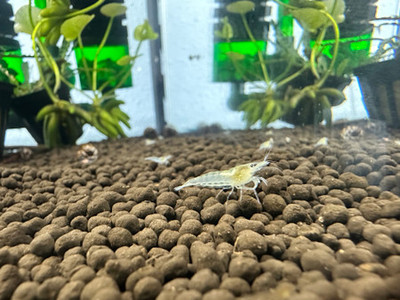Snowball Dwarf Shrimp
Posted by Max Gandara on on 29th Jan 2025
Discovering the Snowball Dwarf Shrimp
Aquatic enthusiasts are often on the lookout for unique and vibrant additions to their aquariums. One such captivating creature is the Snowball Dwarf Shrimp. Known for its striking appearance and gentle nature, this tiny crustacean is a delightful choice for both novice and experienced aquarium keepers. In this blog, we will explore the fascinating world of the Snowball Dwarf Shrimp, from its origins to care tips and beyond.
Origin and Appearance
The Snowball Dwarf Shrimp, scientifically known as Neocaridina cf. zhangjiajiensis, hails from the freshwaters of China. Its name is derived from the shrimp's unique white or translucent body that resembles tiny snowballs. These shrimps are often admired for their delicate and ethereal appearance, which can add a touch of elegance to any aquarium.
Snowball Dwarf Shrimps are relatively small, typically growing to about 1-1.5 inches in length. Their bodies are adorned with prominent white eggs, especially in females, which add to their visual appeal. This feature is not just aesthetic; it is also a sign of good health and successful breeding.
Ideal Habitat and Tank Conditions
Creating the perfect environment for your Snowball Dwarf Shrimp is essential for their well-being. Here are some key factors to consider:
- Tank Size: A minimum of 5 gallons is recommended, though larger tanks are preferable for stability and to accommodate more shrimp.
- Water Parameters: Snowball Dwarf Shrimp thrive in slightly alkaline water with a pH of 6.5 to 8.0. The water temperature should be maintained between 68°F and 78°F.
- Substrate: A dark substrate can help accentuate the shrimp's white coloration and create a visually appealing contrast.
- Plants and Hiding Spots: Providing live plants and hiding spots, such as driftwood or rocks, is crucial. These elements mimic their natural habitat and offer security.
Diet and Feeding
Snowball Dwarf Shrimps are omnivorous and have a varied diet. They can be fed a combination of commercially available shrimp pellets, algae wafers, and blanched vegetables like spinach or zucchini. It is important to provide a balanced diet to ensure they receive all necessary nutrients.
Here are some feeding tips:
- Feed small amounts once or twice a day.
- Remove uneaten food to prevent water quality issues.
- Supplement their diet with protein-rich foods occasionally, such as brine shrimp or bloodworms.
Breeding and Reproduction
One of the fascinating aspects of keeping Snowball Dwarf Shrimp is their ability to reproduce relatively easily in captivity. Here are some insights into their breeding process:
- Maturity: Snowball Dwarf Shrimps reach sexual maturity at around 3-5 months of age.
- Breeding Conditions: Maintain optimal water conditions and provide plenty of hiding spaces to encourage breeding.
- Egg Development: Female shrimps carry eggs under their swimmerets, and these eggs are visible as white clusters. The incubation period lasts around 30 days.
- Baby Shrimps: Once hatched, baby shrimps are fully formed and begin foraging immediately. They require no special care but benefit from a well-established tank with abundant biofilm.
Compatibility and Community
Snowball Dwarf Shrimps are peaceful creatures and can coexist with a variety of other species. However, it is crucial to choose tank mates carefully to avoid predation. Ideal companions include:
- Other dwarf shrimp species
- Small, non-aggressive fish like neon tetras or guppies
- Snails
Avoid housing them with larger, aggressive fish that may view them as a food source.
Conclusion
The Snowball Dwarf Shrimp is an enchanting addition to any freshwater aquarium. With their stunning appearance and ease of care, they offer a rewarding experience for aquarists of all levels. By providing the right environment and diet, you can enjoy the beauty and charm of these delightful creatures for years to come. Happy shrimp keeping!

